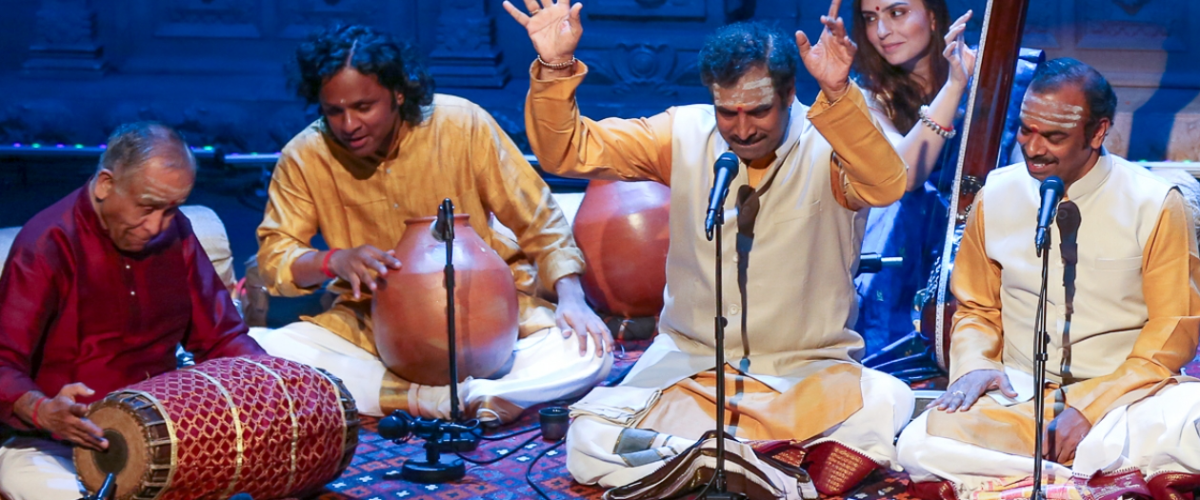

The present-day format of Carnatic music performance is thought to have grown out of the tremendous flowering, especially of music and dance, in the district of Thanjavar during the reign of King Ragunath Nayak, a major 17th-century patron of the arts. From this time until the 19th century, patronage for the music scene came only from royal courts or temples.
There were three clearly defined performance contexts: first, at the royal courts and palaces, where the ruling genre was vocal or veena and, from the 18th century onwards, the songs composed by what has now become known as the Holy Trinity of composers: Thyagaraja, Muthuswami Dikshithar, and Shyama Shastri. The second performance context was at the temple where specific songs were performed as part of religious rituals, ceremonies or festivals.
The third and most popular context was the music that accompanied temple dances performed by an ensemble usually including a vocalist, an instrumental accompanist and any number of percussionists, with a repertoire consisting of items composed specifically for dance. Such pieces are still performed today, irrespective of whether or not a dancer is present.
Although improvisation plays an important role, pre-composed vocal music remains the dominant form of Carnatic music. Even where there is no vocalist and the recital is purely instrumental, the music is nearly always drawn from the vocal repertoire and is usually performed by a small ensemble consisting of a soloist (instrumental or vocal), a melodic accompaniment which is usually a violin although the harmonium is also fairly prevalent nowadays. Percussion accompaniment is usually provided by South India’s commonest drum, the mridangam, which can be joined by a ghatam or kanjira. There is also a tanpura which provides a constant drone.
A genre known as kriti, an extended song composition in 3 parts, forms the backbone of a Carnatic music concert and usually takes up the greater share of performance time but other genres can also feature prominently. A typical performance lasting two or three hours will often begin with a varnam (a melodic exploration sung with simple phrases) as a prelude to the first kriti song and usually in the same raga. This can be followed by a kalpanaswaram (improvising the notes of a chosen raga within the stylistic rules of this form) before moving on to the main compositional segment of the performance.
This section of the performance is often prefaced by an alapana (slow, pulse-free introduction) before going on to a niraval or a three-part song genre called the ragam-tanam-pallavi, often referred to as RTP. In most concerts, whatever the main item, it features at least one section known as tani avartanam in which one or more percussionists perform solo displaying their skills through various complex rhythmic patterns. The recital of a thillana is a popular way to conclude a performance.
Generally, audiences at concerts of Carnatic music tend to be very well informed about the music and its repertoire and quite often, after the main recital section has ended, will make requests for specific kritis or other shorter pieces.
Listen to the music | The Lalgudi siblings (GJR Krishnan and Vijayalakshmi) attack a fierce thillana composition by their father Lalgudi G Jayaraman, to conclude their concert at Darbar Festival 2018.
Jameela Siddiqi is an author, linguist, and BBC cultural commentator, specialising in postcolonial fiction and the devotional music of South Asia.
Darbar believes in the power of Indian classical music to stir, thrill, and inspire. Explore our YouTube channel, or subscribe to the Darbar Concert Hall to watch extended festival performances, talk and documentaries in pristine HD and UHD quality.
Discover Indian classical music via styles you like - this article builds sonic bridges to rock, jazz, jungle,...
Read More 
Exploring ten strange, beautiful instruments from India's classical traditions. By George Howlett | Part of Living...
Read More 
Welcome to Living Traditions - a new written collection by Darbar's George Howlett, exploring how music with ancient...
Read More 
The beginner's guide to Indian classical music. Whether you’re completely new to raga music or just need a refresher, we’ve put together this brief overview of all things raga music to help you feel at ease when visiting one of our concerts or watch our videos on our YouTube or our Darbar Concert Hall.

Keep up to date with the latest news, events, music and musings across our social channels
For hundreds more clips and shorts, vist our YT page here 
Be the first to hear before events go on sale. Get the latest news and articles from Darbar